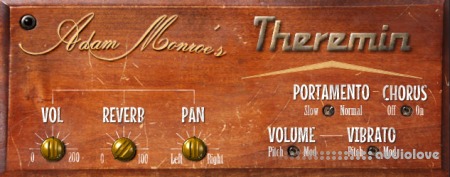Adam Monroe Music Theremin v1.4 [WiN, MacOSX]

Team DECiBEL | 16 April 2020 | WiN: 12 MB | MAC: 18 MB
The theremin is an electronic instrument patented in 1928 by Leon Theremin. The typical theremin users two oscillators - one producing a static frequency, one variable - and amplifies the difference of these two signals to produce sine waves at different frequencies, thus creating different pitches. A theremin uses a secondary circuit to control amplitude. You can control pitch/volume with your hands by adjusting the position of your hands in relation to the two antennas of the theremin, thus making it one of the only instruments in the world that you play but never touch!
The tone of the theremin is well known, and can be heard in countless horror scores because of its somewhat unnatural and haunting tone. Theoretically, a theremin produces a fundamental pitch as a pure sine wave, and pure sine waves sound unnatural because most sounds in nature come with overtones.
The theremin is considered to be one of the worlds most challenging instruments to play. Not only is a theremin "fretless" like a violin, but even stringless, and the tone it produces is not stopped by inaction or through natural decay, but rather by manually decreasing the volume. In other words, to produces staccato notes, one must control not only the attack and hold, but also the decay. This is counterintuitive to how almost every other instrument works.
In essence, the theremin was the worlds first synthesizer, using electronics to "synthesize" a pure electrical tone. We have endeavored to recreate the sound and feel of this instrument by focusing on things like portamento and vibrato, as without properly simulated technique, a theremin simulator would be little more than a sine-wave generator.
ENGINEERING
Sampling a theremin would be somewhat counterintuitive, as the great bulk of a theremin's sound has to do with smooth portamento/slides. A theremin produces a continuous signal that can only be lowered in amplitude, but never truly stops, so that transitioning from one pitch to another will always produce portamento, unless the previous note has been muted.
Our programming seeks to implement much of this behaviour. Our tones are generated by pure mathematical sine waves. You can play notes with portamento between them, and you can play more distinct staccato notes as long as you allow notes to decay at least a little between triggers. Our theremin is monophonic, so you will never hear more than frequency, which is how a physical theremin works. Vibrato and volume can be controlled by either the pitch or mod wheels in order to make an unnatural signal sound more human.
Programming a theremin vst aax, audio unit plugin isn't as easy as it sounds, because getting a monophonic signal to portamento properly and decay convincingly well at the same time sounding natural and being easy to control is a bit of a balancing act. However, we feel that we've done a good job balancing controllability with ease of use and sound quality, so that the end result is a vst instrument that is easy to play and that sounds good.
Amplitude and vibrato can be controlled individually or together via the pitch and/or mod wheels. portamento can be set to regular or slow, but portamento speed will decrease or increase in regards to the interval that is played (closer notes portamento at a faster rate). Chorus and reverb effects are included and will allow you to create slightly different tones. Purchase includes Windows and Mac VST and AAX versions, as well as a Mac OS X Audio Unit version. The Audio Unit version requires OS X 10.9 (Mavericks) or later.
*Full Keyboard Range (A0-C8)
*Portamento, Vibrato, Reverb, Chorus, and Drive Effects
*Phase, Smooth, Noise, Samplre Rate Selection, and Cent-Tuning
*Supports 44.1, 48, 88.2, and 96kHz.
Download Liks:
https://rapidgator.net/file/6be5caaffb5d6aac461eb575ae33c02a
https://rapidgator.net/file/4ed4ef5ea087ca9e2d75e93ec6a210ca
百度云下载地址:

![Focus Music New Age King 3 [WAV]](https://hkaudioz-1259420093.file.myqcloud.com/wp-content/uploads/2022/12/1672185189-20221227235309-63ab856585753-220x180.jpg)
![Dream State Audio Sounds From 7ink Vol.1 (RNB) Drum Kit [WAV]](https://hkaudioz-1259420093.file.myqcloud.com/wp-content/uploads/2022/12/1672185186-20221227235306-63ab8562182cb-220x180.jpg)
![Gio Israel Flamenco Essentials Percussion Vol.2 [WAV]](https://hkaudioz-1259420093.file.myqcloud.com/wp-content/uploads/2022/12/1672185181-20221227235301-63ab855df1ff8-220x180.jpg)
![Modartt Pianoteq Pro Portable v6.7.0 [WiN]](https://hkaudioz-1259420093.file.myqcloud.com/wp-content/uploads/2020/05/20200523094315-5ec8f033cb462.jpg)
![Splice Originals Japanese Percussion with Kaoru Watanabe [WAV]](https://hkaudioz-1259420093.file.myqcloud.com/wp-content/uploads/2020/05/20200526100038-5ecce8c678bf4.jpg)
![Muze Effects [KONTAKT]](https://hkaudioz-1259420093.file.myqcloud.com/wp-content/uploads/2020/03/20032010_muze-effects.jpg)

![MixWithTheMasters Inside The Track 8 Tom Lord-Alge [TUTORiAL]](https://hkaudioz-1259420093.file.myqcloud.com/wp-content/uploads/2020/04/11042060_mixwiththemasters-inside-the-track-8-tom-lord-alge-1.jpg)
![Focus Music New Age King 3 [WAV]](https://hkaudioz-1259420093.file.myqcloud.com/wp-content/uploads/2022/12/1672185189-20221227235309-63ab856585753-70x70.jpg)
![Dream State Audio Sounds From 7ink Vol.1 (RNB) Drum Kit [WAV]](https://hkaudioz-1259420093.file.myqcloud.com/wp-content/uploads/2022/12/1672185186-20221227235306-63ab8562182cb-70x70.jpg)
![Gio Israel Flamenco Essentials Percussion Vol.2 [WAV]](https://hkaudioz-1259420093.file.myqcloud.com/wp-content/uploads/2022/12/1672185181-20221227235301-63ab855df1ff8-70x70.jpg)
![Drip Chord Huncho Chords Vol.1 [WAV, MiDi]](https://hkaudioz-1259420093.file.myqcloud.com/wp-content/uploads/2022/12/1672185181-20221227235301-63ab855de21be-70x70.jpg)
![Focus Music New Age King 2 [WAV]](https://hkaudioz-1259420093.file.myqcloud.com/wp-content/uploads/2022/12/1672185173-20221227235253-63ab8555a95b6-70x70.jpg)

Hot comments